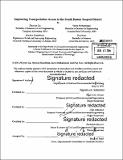Improving transportation access to the South Boston Seaport District
Author(s)
Gu, Zhuyun; Mohammad, Saeed; Kladeftiras, Markos; Xuto, Praj
DownloadFull printable version (62.29Mb)
Other Contributors
Massachusetts Institute of Technology. Department of Civil and Environmental Engineering.
Advisor
Nigel H.M. Wilson, John Attanucci and Frederick Salvucci.
Terms of use
Metadata
Show full item recordAbstract
Boston's Seaport District comprises approximately 1,000 acres of mixed-use residential, commercial and industrial space, which fosters innovation, collaboration and entrepreneurship. Development in the area is occurring fast. Projects that have been completed, proposed, or approved by the Boston Redevelopment Authority as of March 2014 add 10 million square feet of development. Long-term forecasts for the area estimate that an additional 21 million square feet of development will be constructed in the Seaport District by 2030. The overall objective of this thesis is to explore strategies to ensure the Seaport District will have multimodal transportation access to accommodate future economic development. More specific objectives of the thesis are listed as follows: > Lessen road congestion at specific intersections and major streets. > Optimize Silver Line operations. > Improve local bus service. > Assess and enhance bus-priority and parking policies. Thus, the main goals in this thesis are to improve the mobility, accessibility and sustainability of the Seaport District by providing more and higher quality public transport and discouraging access by private car. The evaluation of the public transport and road networks revealed the key weaknesses and issues in the area. The in-depth analyses of the short-term, medium-term, and long-term conditions then illustrated the potential future problems and proposed solutions to address those problems. It was concluded that operational changes in both the transit and road networks can address the issues raised in the short-term. Capital and operational changes are recommended for the medium-term. In the long-term, significant capital improvements and strict parking policies are proposed in order to accommodate the forecast demand.
Description
Thesis: M. Eng., Massachusetts Institute of Technology, Department of Civil and Environmental Engineering, 2014. Cataloged from PDF version of thesis. Includes bibliographical references.
Date issued
2014Department
Massachusetts Institute of Technology. Department of Civil and Environmental EngineeringPublisher
Massachusetts Institute of Technology
Keywords
Civil and Environmental Engineering.